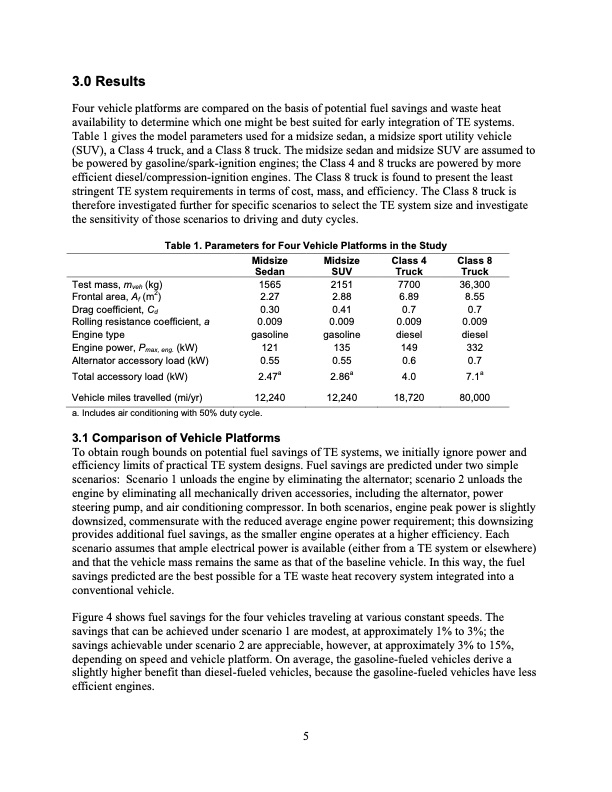
PDF Publication Title:
Text from PDF Page: 012
3.0 Results Four vehicle platforms are compared on the basis of potential fuel savings and waste heat availability to determine which one might be best suited for early integration of TE systems. Table 1 gives the model parameters used for a midsize sedan, a midsize sport utility vehicle (SUV), a Class 4 truck, and a Class 8 truck. The midsize sedan and midsize SUV are assumed to be powered by gasoline/spark-ignition engines; the Class 4 and 8 trucks are powered by more efficient diesel/compression-ignition engines. The Class 8 truck is found to present the least stringent TE system requirements in terms of cost, mass, and efficiency. The Class 8 truck is therefore investigated further for specific scenarios to select the TE system size and investigate the sensitivity of those scenarios to driving and duty cycles. Table 1. Parameters for Four Vehicle Platforms in the Study Test mass, mveh (kg) Frontal area, Af (m2) Drag coefficient, Cd Rolling resistance coefficient, a Engine type Engine power, Pmax, eng. (kW) Alternator accessory load (kW) Total accessory load (kW) Midsize Midsize Sedan SUV 1565 2151 2.27 2.88 0.30 0.41 0.009 0.009 gasoline gasoline 121 135 0.55 0.55 2.47a 2.86a Class 4 Truck 7700 6.89 0.7 0.009 diesel 149 0.6 4.0 18,720 Class 8 Truck 36,300 8.55 0.7 0.009 diesel 332 0.7 7.1a 80,000 Vehicle miles travelled (mi/yr) a. Includes air conditioning with 50% duty cycle. 3.1 Comparison of Vehicle Platforms 12,240 12,240 To obtain rough bounds on potential fuel savings of TE systems, we initially ignore power and efficiency limits of practical TE system designs. Fuel savings are predicted under two simple scenarios: Scenario 1 unloads the engine by eliminating the alternator; scenario 2 unloads the engine by eliminating all mechanically driven accessories, including the alternator, power steering pump, and air conditioning compressor. In both scenarios, engine peak power is slightly downsized, commensurate with the reduced average engine power requirement; this downsizing provides additional fuel savings, as the smaller engine operates at a higher efficiency. Each scenario assumes that ample electrical power is available (either from a TE system or elsewhere) and that the vehicle mass remains the same as that of the baseline vehicle. In this way, the fuel savings predicted are the best possible for a TE waste heat recovery system integrated into a conventional vehicle. Figure 4 shows fuel savings for the four vehicles traveling at various constant speeds. The savings that can be achieved under scenario 1 are modest, at approximately 1% to 3%; the savings achievable under scenario 2 are appreciable, however, at approximately 3% to 15%, depending on speed and vehicle platform. On average, the gasoline-fueled vehicles derive a slightly higher benefit than diesel-fueled vehicles, because the gasoline-fueled vehicles have less efficient engines. 5PDF Image | Feasibility of Thermoelectrics for Waste Heat Recovery in Conventional Vehicles

PDF Search Title:
Feasibility of Thermoelectrics for Waste Heat Recovery in Conventional VehiclesOriginal File Name Searched:
44247.pdfDIY PDF Search: Google It | Yahoo | Bing
NFT (Non Fungible Token): Buy our tech, design, development or system NFT and become part of our tech NFT network... More Info
IT XR Project Redstone NFT Available for Sale: NFT for high tech turbine design with one part 3D printed counter-rotating energy turbine. Be part of the future with this NFT. Can be bought and sold but only one design NFT exists. Royalties go to the developer (Infinity) to keep enhancing design and applications... More Info
Infinity Turbine IT XR Project Redstone Design: NFT for sale... NFT for high tech turbine design with one part 3D printed counter-rotating energy turbine. Includes all rights to this turbine design, including license for Fluid Handling Block I and II for the turbine assembly and housing. The NFT includes the blueprints (cad/cam), revenue streams, and all future development of the IT XR Project Redstone... More Info
Infinity Turbine ROT Radial Outflow Turbine 24 Design and Worldwide Rights: NFT for sale... NFT for the ROT 24 energy turbine. Be part of the future with this NFT. This design can be bought and sold but only one design NFT exists. You may manufacture the unit, or get the revenues from its sale from Infinity Turbine. Royalties go to the developer (Infinity) to keep enhancing design and applications... More Info
Infinity Supercritical CO2 10 Liter Extractor Design and Worldwide Rights: The Infinity Supercritical 10L CO2 extractor is for botanical oil extraction, which is rich in terpenes and can produce shelf ready full spectrum oil. With over 5 years of development, this industry leader mature extractor machine has been sold since 2015 and is part of many profitable businesses. The process can also be used for electrowinning, e-waste recycling, and lithium battery recycling, gold mining electronic wastes, precious metals. CO2 can also be used in a reverse fuel cell with nafion to make a gas-to-liquids fuel, such as methanol, ethanol and butanol or ethylene. Supercritical CO2 has also been used for treating nafion to make it more effective catalyst. This NFT is for the purchase of worldwide rights which includes the design. More Info
NFT (Non Fungible Token): Buy our tech, design, development or system NFT and become part of our tech NFT network... More Info
Infinity Turbine Products: Special for this month, any plans are $10,000 for complete Cad/Cam blueprints. License is for one build. Try before you buy a production license. May pay by Bitcoin or other Crypto. Products Page... More Info
| CONTACT TEL: 608-238-6001 Email: greg@infinityturbine.com | RSS | AMP |